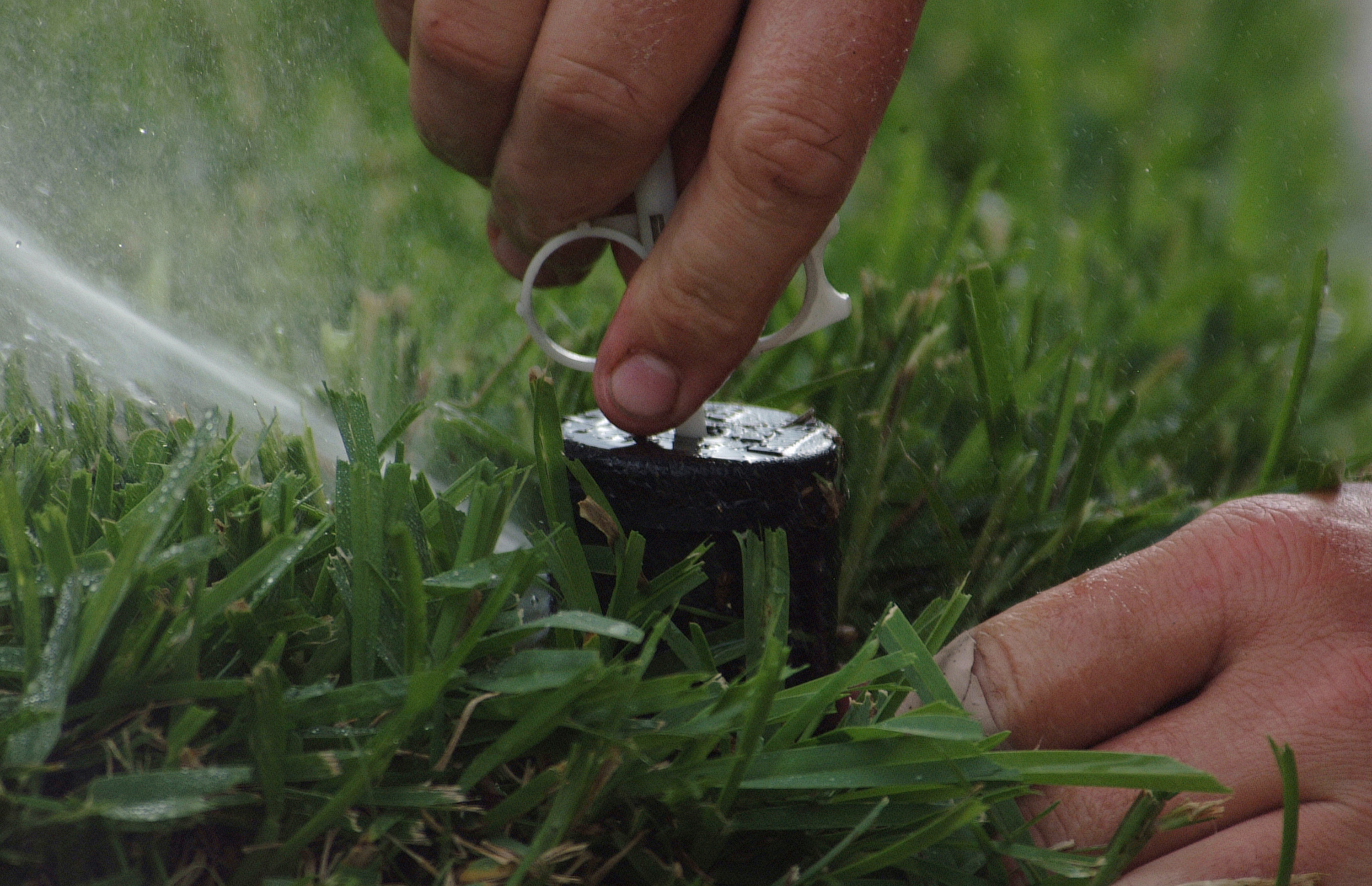
by Sheila Dunning | Apr 5, 2018
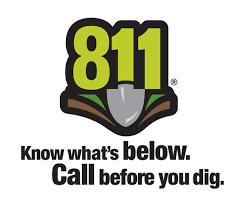 This month, recognized by the Senate and Florida’s governor, reminds diggers why calling 811 before all outdoor digging projects is important to your safety. Before installing a mailbox, fence, deck, garden or tree make sure to call Sunshine 811 to have underground lines marked. 811 is the free national number designated by the Federal Communications Commission. It notifies utility companies, who in turn send their professional locators to identify and mark the appropriate location of underground line with paint and flags in colors that identify the utility type. The following colors represent the seven various utilities: red, orange, blue, green, yellow, purple and white. To see which colors correspond with each utility click on the picture below:
This month, recognized by the Senate and Florida’s governor, reminds diggers why calling 811 before all outdoor digging projects is important to your safety. Before installing a mailbox, fence, deck, garden or tree make sure to call Sunshine 811 to have underground lines marked. 811 is the free national number designated by the Federal Communications Commission. It notifies utility companies, who in turn send their professional locators to identify and mark the appropriate location of underground line with paint and flags in colors that identify the utility type. The following colors represent the seven various utilities: red, orange, blue, green, yellow, purple and white. To see which colors correspond with each utility click on the picture below:
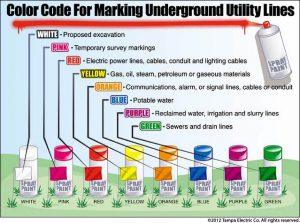
Hitting an underground utility line while digging can cause injuries, utility service outages to an entire neighborhood and damage to the environment. Failure to call before digging results in one unintentional utility hit every eight minutes nationwide. You could also be financially affected with costly fines and high repair costs.
Calling 811 in Florida is the law. At least two full business days before digging, do-it yourselfers and professional excavators must contact 811 by phone to start the process of getting underground utility lines marked. This is a free service. Be sure that all utilities have been marked before grabbing the shovel. Follow up on your one call ticket by contacting 811 again on the third day. For more information on Florida’s law, visit www.Sunshine811.com.
by Sheila Dunning | Jan 5, 2018
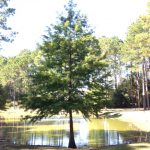
Bald Cypress. Photo: J_McConnell, UF/IFAS
The best time to plant a tree is twenty years ago. The second best time is Arbor Day. Florida recognizes the event on the third Friday in January, but planting any time before spring will establish a tree quickly.
Arbor Day is an annual observance that celebrates the role of trees in our lives and promotes tree planting and care. As a formal holiday, it was first observed on April 10, 1872 in the state of Nebraska. Today, every state and many countries join in the recognition of trees impact on people and the environment.
Trees are the longest living organisms on the planet and one of the earth’s greatest natural resources. They keep our air supply clean, reduce noise pollution, improve water quality, help prevent erosion, provide food and building materials, create shade, and help make our landscapes look beautiful. A single tree produces approximately 260 pounds of oxygen per year. That means two mature trees can supply enough oxygen annually to support a family of four.
The idea for Arbor Day in the U.S. began with Julius Sterling Morton. In 1854 he moved from Detroit to the area that is now the state of Nebraska. J. Sterling Morton was a journalist and nature lover who noticed that there were virtually no trees in Nebraska. He wrote and spoke about environmental stewardship and encouraged everyone to plant trees. Morton emphasized that trees were needed to act as windbreaks, to stabilize the soil, to provide shade, as well as fuel and building materials for the early pioneers to prosper in the developing state.
In 1872, The State Board of Agriculture accepted a resolution by J. Sterling Morton “to set aside one day to plant trees, both forest and fruit.” On April 10, 1872 one million trees were planted in Nebraska in honor of the first Arbor Day. Shortly after the 1872 observance, several other states passed legislation to observe Arbor Day. By 1920, 45 states and territories celebrated Arbor Day. Richard Nixon proclaimed the last Friday in April as National Arbor Day during his presidency in 1970.
Today, all 50 states in the U.S. have official Arbor Day, usually at a time of year that has the correct climatological conditions for planting trees. For Florida, the ideal tree planting time is January, so Florida’s Arbor Day is celebrated on the third Friday of the month. Similar events are observed throughout the world. In Israel it is the Tu B Shevat (New Year for Trees). Germany has Tag des Baumes. Japan and Korea celebrate an entire week in April. Even Iceland, one of the treeless countries in the world observes Student’s Afforestation Day.
The trees planted on Arbor Day show a concern for future generations. The simple act of planting a tree represents a belief that the tree will grow and someday provide wood products, wildlife habitat, erosion control, shelter from wind and sun, beauty, and inspiration for ourselves and our children.
“It is well that you should celebrate your Arbor Day thoughtfully, for within your lifetime the nation’s need of trees will become serious. We of an older generation can get along with what we have, though with growing hardship; but in your full manhood and womanhood you will want what nature once so bountifully supplied and man so thoughtlessly destroyed; and because of that want you will reproach us, not for what we have used, but for what we have wasted.”
~Theodore Roosevelt, 1907 Arbor Day Message
by Sheila Dunning | Aug 26, 2016
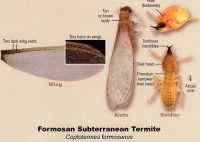 The genus Coptotermes contains the largest number of termite pests (28 species) worldwide, with the Formosan subterranean termite, Coptotermes formosansus, being the most widely distributed and most economically important. During the 1960’s it was found in Texas, Louisiana, and South Carolina. The first well-established colony in Florida was reported in 1980.
The genus Coptotermes contains the largest number of termite pests (28 species) worldwide, with the Formosan subterranean termite, Coptotermes formosansus, being the most widely distributed and most economically important. During the 1960’s it was found in Texas, Louisiana, and South Carolina. The first well-established colony in Florida was reported in 1980.
A single colony of Formosan subterranean termite may contain several million termites that forage up to 300 feet in soil. Once established, the Formosan subterranean termite has never been eradicated from an area. Therefore, monitoring of movement of the species is critical. Beginning in 2015, the Florida Department of Agriculture of Consumer Science (FDACS) began trapping the alates. Termites have three primary castes: the reproductive, soldiers, and workers. Within the reproductive caste, the young females, referred to as alates, are the ones that leave the colony. They are able to form wings and seek new areas to become established. Dispersal flights or “swarms” are massive and begin at dusk on calm and humid evenings from April to July. Alates are attracted to lights.
The objective of the FDACS Formosan Termite Alate project is to trap alates throughout the four most western counties of the Panhandle during their major swarm season in May and June, which is the time they are most active in that part of Florida. Trapped alates were counted on a weekly basis to determine peak swarming weeks. White, gridded 7”x 4” sticky card attached to 6’ stakes are placed under strong, predetermined street lights. Twenty-two trap locations were selected, each representing a key Panhandle community with at least one location North of I-10 within each of the four counties.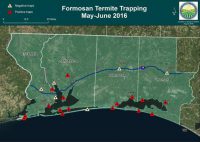
In 2016, sixteen out of the 22 traps were positive for Formosan termite alates throughout the four Panhandle counties. Formosan alates were caught during 7 of the 8 weeks of trapping. The largest spike in numbers trapped was during the week of May 8th. A subsequent swarming spike occurred during the week of May 22nd. Trap locations that were positive in 2016 and not 2015 included Pensacola Beach, Destin, Blue Mountain Beach, Okaloosa Island and Choctaw Beach. The project will be continued each year in order to determine some of the problem areas.
For more information go to:
by Sheila Dunning | Aug 26, 2016
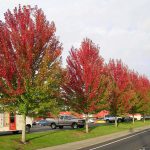 Red Maples are among the most frequently planted urban trees. Many of its features, especially its leaves are quite variable in form. Its flowers, petioles, twigs and seeds are all red to varying degrees. But, it is best known for its brilliant deep scarlet foliage in autumn. Red Maple is adaptable to a wide range of site conditions, perhaps more so than any other tree in eastern North America. It can be found growing in swamps, on poor dry soils, and most anywhere in between. However, the tree health and appearance decreases when trees have more impervious surfaces around them.
Red Maples are among the most frequently planted urban trees. Many of its features, especially its leaves are quite variable in form. Its flowers, petioles, twigs and seeds are all red to varying degrees. But, it is best known for its brilliant deep scarlet foliage in autumn. Red Maple is adaptable to a wide range of site conditions, perhaps more so than any other tree in eastern North America. It can be found growing in swamps, on poor dry soils, and most anywhere in between. However, the tree health and appearance decreases when trees have more impervious surfaces around them.
North Carolina State University research has developed the impervious surface threshold (http://content.ces.ncsu.edu/impervious-surface-threshold-for-sustainable-urban-tree-planting-and-landscaping-design) which can be used to identify planting sites where Red Maple will thrive. Landscape architects, urban planners, arborists, landscapers, and other professionals can use these impervious surface thresholds to reduce Red Maple management and replacement costs.
Trees surrounded by less than 33% impervious surface cover will most likely be in good or excellent condition. Trees surrounded by 33%-66% are likely to be in fair condition. Trees surrounded by 67% or more tend to be in poor condition. Impervious surface cover can be measured by using the “Pace to Plant” technique.
The “Pace to Plant” technique is a tool to quickly and accurately quantify the amount of impervious surface surrounding a tree or planting site. Begin by standing at the planting site and identify the closest impervious surface edge. Take 25 steps at 45⁰ to the nearest impervious edge, counting only the steps that land on the impervious surface. Then, return to the identified planting site and begin walking 25 steps in the opposite direction. Again, only count the steps that fall onto impervious surface. If you encounter a building or wall, count the remainder of the steps as impervious. One more time, return to the starting planting site. This time turn 90° and begin walking 25 steps and count the steps that fall onto impervious surface. Finally, turn around and go back to the planting site and begin walking in the opposite direction for 25 steps. This will be the fourth time that steps falling onto the impervious surface are counted. Having walked in four directions located 90° from each other, completing an “X” through the planting site, the transect is final with a total of 100 steps have been taken. By totaling the number of steps that fall onto impervious surfaces the percentage of the surrounding ground area can be determined. For example, if the total number of steps falling on impervious surface is 65 (out of the potentially 100 steps), the percentage of impervious surface is 65%. Using the established criteria, the site would not be suitable for planting a Red Maple.
While North Carolina State has only researched the Red Maple tree species, the “Pace to Plant” technique could be used to determine suitable sites for many different trees being considered for commercial urban planting.
By evaluating the impervious surface restrictions, better tree species selection may be possible. If the right tree for the right place is chosen well, stress to urban trees, including pest infestations, can be reduced.
by Sheila Dunning | Mar 24, 2016
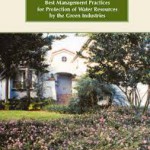 On June 18, 2009, Florida Governor Charlie Crist signed into law SB 494 requiring all commercial fertilizer applicators have a license by January 1, 2014. Passing the Green Industries Best Management Practices (GI-BMP) training is mandatory to obtain that license. University of Florida/IFAS Extension provides training and testing programs in urban landscape management practices and issues certificates demonstrating satisfactory completion of the training. These classes are available in English, Spanish, or Haitian Creole.
On June 18, 2009, Florida Governor Charlie Crist signed into law SB 494 requiring all commercial fertilizer applicators have a license by January 1, 2014. Passing the Green Industries Best Management Practices (GI-BMP) training is mandatory to obtain that license. University of Florida/IFAS Extension provides training and testing programs in urban landscape management practices and issues certificates demonstrating satisfactory completion of the training. These classes are available in English, Spanish, or Haitian Creole.
After receiving a certificate of completion of the GI-BMP training, a person must pay $25 and apply with Florida Department of Agriculture and Consumer Services (FDACS) to receive the Limited Certification for Urban Landscape Commercial Fertilizer (LCULCF) also commonly called the “fertilizer license.” You can apply online or download the paper application and apply by mail.
There has been a lot of confusion over which certificate is needed by the applicator. Many individuals have not completed the second step of the process and are not in compliance with current state laws. If you are unsure which certification you hold, check your wallet card for the identification number; an FDACS issued certification will begin with “LF” and the GI-BMP certification begins with “GV.” You must have the FDACS certification beginning with “LF” to apply fertilizer for-hire.
The LCULCF certification expires 4 years after the date of issuance. Continuing education of two hours of F.S. 482 General Standards CORE and two hours of the category Limited Urban Fertilizer are required for renewal. Those that received their LCULCF certification before the 2014 deadline may be approaching the need for renewal.
The good news is, if you passed the GI-BMP certification but failed to take the next step towards FDACS certification your GI-BMP training certificate is non-expiring and you can still apply for the LCULCF without attending the training again. Not sure if you have successfully completed this program? You can check here the list of certificate holders by county at http://ffl.ifas.ufl.edu/professionals/certification_lists/cert_county_name.shtml.
If you did pass the course, but cannot locate your GI-BMP certificate, you can request a replacement copy here.
Using UF/IFAS-recommended application rates and timing of pesticides, fertilizer and irrigation can help prevent nonpoint source pollution (water pollution that is associated with everyday human activities and driven by rainfall, runoff and leaching) from urban landscapes. By choosing plants appropriate for the site and maintaining them with correct cultural practices (irrigation, fertilization, mowing and pruning), one can significantly reduce the amount of water a landscape needs to thrive.
The GI-BMP class teaches landscape workers how to implement these Best Management Practices into their daily work. This is an opportunity for Green Industry workers to complete this requirement and market their skills to clientele. Trainings are available monthly across the Panhandle as well as on-line. Visit the website for more information http://fyn.ifas.ufl.edu/professionals/BMP_overview.htm.


 The genus Coptotermes contains the largest number of termite pests (28 species) worldwide, with the Formosan subterranean termite, Coptotermes formosansus, being the most widely distributed and most economically important. During the 1960’s it was found in Texas, Louisiana, and South Carolina. The first well-established colony in Florida was reported in 1980.
The genus Coptotermes contains the largest number of termite pests (28 species) worldwide, with the Formosan subterranean termite, Coptotermes formosansus, being the most widely distributed and most economically important. During the 1960’s it was found in Texas, Louisiana, and South Carolina. The first well-established colony in Florida was reported in 1980.
 Red Maples are among the most frequently planted urban trees. Many of its features, especially its leaves are quite variable in form. Its flowers, petioles, twigs and seeds are all red to varying degrees. But, it is best known for its brilliant deep scarlet foliage in autumn. Red Maple is adaptable to a wide range of site conditions, perhaps more so than any other tree in eastern North America. It can be found growing in swamps, on poor dry soils, and most anywhere in between. However, the tree health and appearance decreases when trees have more impervious surfaces around them.
Red Maples are among the most frequently planted urban trees. Many of its features, especially its leaves are quite variable in form. Its flowers, petioles, twigs and seeds are all red to varying degrees. But, it is best known for its brilliant deep scarlet foliage in autumn. Red Maple is adaptable to a wide range of site conditions, perhaps more so than any other tree in eastern North America. It can be found growing in swamps, on poor dry soils, and most anywhere in between. However, the tree health and appearance decreases when trees have more impervious surfaces around them.
 On June 18, 2009, Florida Governor Charlie Crist signed into law SB 494 requiring all commercial fertilizer applicators have a license by January 1, 2014. Passing the Green Industries Best Management Practices (GI-BMP) training is mandatory to obtain that license. University of Florida/IFAS Extension provides training and testing programs in urban landscape management practices and issues certificates demonstrating satisfactory completion of the training. These classes are available in English, Spanish, or Haitian Creole.
On June 18, 2009, Florida Governor Charlie Crist signed into law SB 494 requiring all commercial fertilizer applicators have a license by January 1, 2014. Passing the Green Industries Best Management Practices (GI-BMP) training is mandatory to obtain that license. University of Florida/IFAS Extension provides training and testing programs in urban landscape management practices and issues certificates demonstrating satisfactory completion of the training. These classes are available in English, Spanish, or Haitian Creole.

